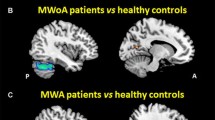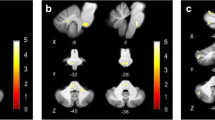Abstract
Although vestibular neuritis (VN) cortical models are described in the literature, there is lack of knowledge regarding the exclusive cerebellar involvement. The aim of the present study was to analyze, by [18F] fluorodeoxyglucose-positron emission tomography (FDG-PET)/computer tomography, regional cerebellar FDG uptake in eight right-handed VN patients (five females; three males; mean age 48 ± 7 years) during the first few days (PET0) and after 1 month (PET1) since symptoms onset. At both phases, patients underwent otoneurological examination and filled in a battery of validated questionnaires. Twenty-six cerebellar volumes of interest (VOI) were identified by the automated anatomical labeling library and normalized to thalamus FDG-PET uptake. Mean intensity within VOIs was calculated in both phases and processed by within-subjects ANOVA. A significantly lower (p < 0.005) FDG uptake distribution was found in bilateral lobules III, VI and X and in vermis 1–2, 3, 6 and 10 at PET0 as compared to PET1 and a significant higher FDG uptake distribution was found in right crus I in the same comparison. Significant (p < 0.05) positive correlations were found between Anxiety and Bucket test scores, and normalized metabolism in right crus I (at PET0) and vermis 10 (at PET1), respectively. A negative correlation was found at PET0 between slow-phase velocity scores and normalized metabolism in right lobule X. These data show relevant changes in the pattern of cerebellar metabolism that might unravel additional central aspects of early and late VN associated to bilateral cortical responses to sensory conflict during the acute VN-related controversial inflow.



Similar content being viewed by others
References
Alessandrini M, Pagani M, Napolitano B, Micarelli A, Candidi M, Bruno E et al (2013) Early and phasic cortical metabolic changes in vestibular neuritis onset. PLoS One 8:e57596
Strupp M, Brandt T (2009) Vestibular neuritis. Semin Neurol 29:509–519
Pollak L, Klein C, Rafael S, Vera K, Rabey JM (2003) Anxiety in the first attack of vertigo. Otolaryngol Head Neck Surg 128:829–834
Tschan R, Wiltink J, Best C, Bense S, Dieterich M, Beutel ME et al (2008) German version of the Vertigo Symptom Scale (VSS) in patients with organic orsomatoform dizziness and healthy controls. J Neurol 255:1168–1175
Candidi M, Micarelli A, Viziano A, Aglioti SM, Minio-Paluello I, Alessandrini M (2013) Impaired mental rotation in benign paroxysmal positional vertigo and acute vestibular neuritis. Front Hum Neurosci 7:783. doi:10.3389/fnhum.2013.00783
Brandt T, Bartenstein P, Janek A, Dieterich M (1998) Reciprocal inhibitory visual-vestibular interaction. Visual motion stimulation deactivates the parietoinsular vestibular cortex. Brain 121:1749–1758
Bense S, Bartenstein P, Lochmann M, Schlindwein P, Brandt T, Dieterich M (2004) Metabolic changes in vestibular and visual cortices in acute vestibular neuritis. Ann Neurol 56:624–630
Dieterich M, Brandt T (2008) Functional brain imaging of peripheral and central vestibular disorders. Brain 131:2538–2552
Dieterich M, Brandt T (2010) Imaging cortical activity after vestibular lesions. Restor Neurol Neurosci 28:47–56
Helmchen C, Klinkenstein J, Machner B, Rambold H, Mohr C, Sander T (2009) Structural changes in the human brain following vestibular neuritis indicate central vestibular compensation. Ann N Y Acad Sci 1164:104–115
Angelaki DE, Cullen KE (2008) Vestibular system: the many facets of a multimodal sense. Annu Rev Neurosci 31:125–150
Eulenburg P, Stoeter P, Dieterich M (2010) Voxel-based morphometry depicts central compensation after vestibular neuritis. Ann Neurol 68:241–249
Cooper CW (1993) Vestibular neuronitis: a review of a common cause of vertigo in general practice. Br J Gen Pract 43:164–167
Varrone A, Asenbaum S, Vander Borght T, Booij J, Nobili F, Någren K, European Association of Nuclear Medicine Neuroimaging Committee et al (2009) EANM procedure guidelines for PET brain imaging using [18F]FDG, version 2. Eur J Nucl Med Mol Imaging 36:2103–2110
Honrubia V (1994) Quantitative vestibular function tests and the clinical examination. In: Herdman SJ (ed) Vestibular rehabilitation. Davis, Philadelphia, pp 113–164
Zwergal A, Rettinger N, Frenzel C, Dieterich M, Brandt T, Strupp M (2009) A bucket of static vestibular function. Neurology 72:1689–1692
Gomez-Alvarez FB, Jauregui-Renaud K (2011) Psychological symptoms and spatial orientation during the first 3 months after acute unilateral vestibular lesion. Arch Med Res 42:97–103
Zung WK (1971) A rating instrument for anxiety disorders. Psychosomatics 12:371–379
Cox BJ, Swinson RP (2002) Instrument to assess depersonalization/derealization in panic disorder. Depress Anxiety 15:172–175
Pagani M, Chiò A, Valentini MC, Öberg J, Nobili F, Calvo A et al (2014) Functional pattern of brain FDG-PET in amyotrophic lateral sclerosis. Neurology (in press)
Tzourio-Mazoyer N, Landeau B, Papathanassiou D, Crivello F, Etard O, Delcroix N et al (2002) Automated anatomical labelling of activations in spm using a macroscopic anatomical parcellation of the MNI MRI single subject brain. Neuroimage 15:273–289
Schmahmann JD, Doyon J, McDonald D, Holmes C, Lavoie K, Hurwitz AS et al (1999) Three-dimensional MRI atlas of the human cerebellum in proportional stereotaxic space. Neuroimage 10:233–260
Schmahmann JD (2010) The role of the cerebellum in cognition and emotion: personal reflections since 1982 on the dysmetria of thought hypothesis, and its historical evolution from theory to therapy. Neuropsychol Rev 20:236–260
Diedrichsen J (2006) A spatially unbiased atlas template of the human cerebellum. Neuroimage 33:127–138
Diedrichsen J, Balsters JH, Flavell J, Cussans E, Ramnani N (2009) A probabilistic MR atlas of the human cerebellum. Neuroimage 46:39–46
Stoodley CJ, Schmahmann JD (2009) Functional topography in the human cerebellum: a meta-analysis of neuroimaging studies. Neuroimage 44:489–501
Stoodley CJ, Valera EM, Schmahmann JD (2012) Functional topography of the cerebellum for motor and cognitive tasks: an fMRI study. Neuroimage 59:1560–1570
Stoodley CJ, Schmahmann JD (2010) Evidence for topographic organization in the cerebellum of motor control versus cognitive and affective processing. Cortex 46:831–844
Schmahmann JD, Macmore J, Vangel M (2009) Cerebellar stroke without motor deficit: clinical evidence for motor and non-motor domains within the human cerebellum. Neuroscience 162:852–861
Keren-Happuch E, Chen SH, Ho MH, Desmond JE (2014) A meta-analysis of cerebellar contributions to higher cognition from PET and fMRI studies. Hum Brain Mapp 35:593–615
Habas C, Kamdar N, Nguyen D, Prater K, Beckmann CF, Menon V et al (2009) Distinct cerebellar contributions to intrinsic connectivity networks. J Neurosci 29:8586–8594
Manni E, Petrosini L (2004) A century of cerebellar somatotopy: a debated representation. Nat Rev Neurosci 5:241–249
Krienen FM, Buckner RL (2009) Segregated fronto-cerebellar circuits revealed by intrinsic functional connectivity. Cereb Cortex 19:2485–2497
O’Reilly JX, Beckmann CF, Tomassini V, Ramnani N, Johansen-Berg H (2010) Distinct and overlapping functional zones in the cerebellum defined by resting state functional connectivity. Cereb Cortex 20:953–965
Martin TA, Keating JG, Goodkin HP, Bastian AJ, Thach WT (1996) Throwing while looking through prisms. II. Specificity and storage of multiple gaze-throw calibrations. Brain 119:1199–1211
Glickstein M (2000) How are visual areas of the brain connected to motor areas for the sensory guidance of movement? Trends Neurosci 23:613–617
Bauswein E, Kolb FP, Leimbeck B, Rubia FJ (1983) Simple and complex spike activity of cerebellar Purkinje cells during active and passive movements in the awake monkey. J Physiol 339:379–394
Donga R, Dessem D (1993) An unrelayed projection of jaw-muscle spindle afferents to the cerebellum. Brain Res 626:347–350
Wolpert DM, Miall RC, Kawato M (1998) Internal models in the cerebellum. Trends Cogn Sci 2:338–347
Ito M (2001) Cerebellar long-term depression: characterization, signal transduction, and functional roles. Physiol Rev 81:1143–1195
Bays PM, Wolpert DM (2007) Computational principles of sensorimotor control that minimize uncertainty and variability. J Physiol 578:387–396
Glickstein M, Sultan F, Voogd J (2011) Functional localization in the cerebellum. Cortex 47:59–80
Voogd J, Barmack NH (2006) Oculomotor cerebellum. Prog Brain Res 151:231–268
Voogd J, Schraa-Tam CK, van der Geest JN, De Zeeuw CI (2012) Visuomotor cerebellum in human and nonhuman primates. Cerebellum 11:392–410
Angelaki DE, Yakusheva TA, Green AM, Dickman JD, Blazquez PM (2010) Computation of egomotion in the macaque cerebellar vermis. Cerebellum 9:174–182
Yakusheva TA, Shaikh AG, Green AM, Blazquez PM, Dickman JD, DE Angelaki (2007) Purkinje cells in posterior cerebellar vermis encode motion in an inertial reference frame. Neuron 54:973–985
Barmack NH (2003) Central vestibular system: vestibular nuclei and posterior cerebellum. Brain Res Bull 60:511–541
du Lac S, Raymond JL, Sejnowski TJ, Lisberger SG (1995) Learning and memory in the vestibulo-ocular reflex. Annu Rev Neurosci 18:409–441
du Lac S (1996) Candidate cellular mechanisms of vestibulo-ocular reflex plasticity. Ann NY Acad Sci 781:489–498
Hirata Y, Highstein SM (2000) Analysis of the discharge pattern of floccular Purkinje cells in relation to vertical head and eye movement in the squirrel monkey. Prog Brain Res 124:221–332
Blazquez PM, Hirata Y, Heiney SA, Green AM, Highstein SM (2003) Cerebellar signatures of vestibulo-ocular reflex motor learning. J Neurosci 29:9742–9751
Partsalis AM, Zhang Y, Highstein SM (1995) Dorsal Y group in the squirrel monkey. II. Contribution of the cerebellar flocculus to neuronal responses in normal and adapted animals. J Neurophysiol 73:632–650
Rambold H, Churchland A, Selig Y, Jasmin L, Lisberger SG (2002) Partial ablations of the flocculus and ventral paraflocculus in monkeys cause linked deficits in smooth pursuit eye movements and adaptive modification of the VOR. J Neurophysiol 87:912–924
Clower DM, West RA, Lynch JC, Strick PL (2001) The inferior parietal lobule is the target of output from the superior colliculus, hippocampus, and cerebellum. J Neurosci 21:6283–6291
Block HJ, Bastian AJ (2012) Cerebellar involvement in motor but not sensory adaptation. Neuropsychologia 50:1766–1775
Alessandrini M, D’Erme G, Bruno E, Napolitano B, Magrini A (2003) Vestibular compensation: analysis of postural re-arrangement as a control index for unilateral vestibular deficit. NeuroReport 14:1075–1079
Kipping JA, Grodd W, Kumar V, Taubert M, Villringer A, Margulies DS (2013) Overlapping and parallel cerebello-cerebral networks contributing to sensorimotor control: an intrinsic functional connectivity study. Neuroimage 83:837–848
Seeley WW, Menon V, Schatzberg AF, Keller J, Glover GH, Kenna H et al (2007) Dissociable intrinsic connectivity networks for salience processing and executive control. J Neurosci 27:2349–2356
Dimitrova A, Kolb FP, Elles FP, Maschke M, Forsting M, Diener HC et al (2003) Cerebellar responses evoked by nociceptive leg withdrawal reflex as revealed by event-related FMRI. J Neurophysiol 90:1877–1886
Wang D, Buckner RL, Liu H (2013) Cerebellar asymmetry and its relation to cerebral asymmetry estimated by intrinsic functional connectivity. J Neurophysiol 109:46–57
Fox MD, Raichle ME (2007) Spontaneous fluctuations in brain activity observed with functional magnetic resonance imaging. Nat Rev Neurosci 8:700–711
Acknowledgments
MichelAngela Studio generated Fig. 2 with airbrush simulation technique by using Photoshop Package for iOS and modified Fig. 3 by using the same software. The authors express sincerely thanks to MichelAngela Studio for skillful and creative craftsmanship in preparing illustrations.
Conflicts of interest
On behalf of all authors, the corresponding author states that there are no conflicts of interest.
Author information
Authors and Affiliations
Corresponding author
Additional information
M. Alessandrini, A. Micarelli, O. Schillaci and M. Pagani contributed equally to this work.
Rights and permissions
About this article
Cite this article
Alessandrini, M., Micarelli, A., Chiaravalloti, A. et al. Cerebellar metabolic involvement and its correlations with clinical parameters in vestibular neuritis. J Neurol 261, 1976–1985 (2014). https://doi.org/10.1007/s00415-014-7449-x
Received:
Revised:
Accepted:
Published:
Issue Date:
DOI: https://doi.org/10.1007/s00415-014-7449-x




